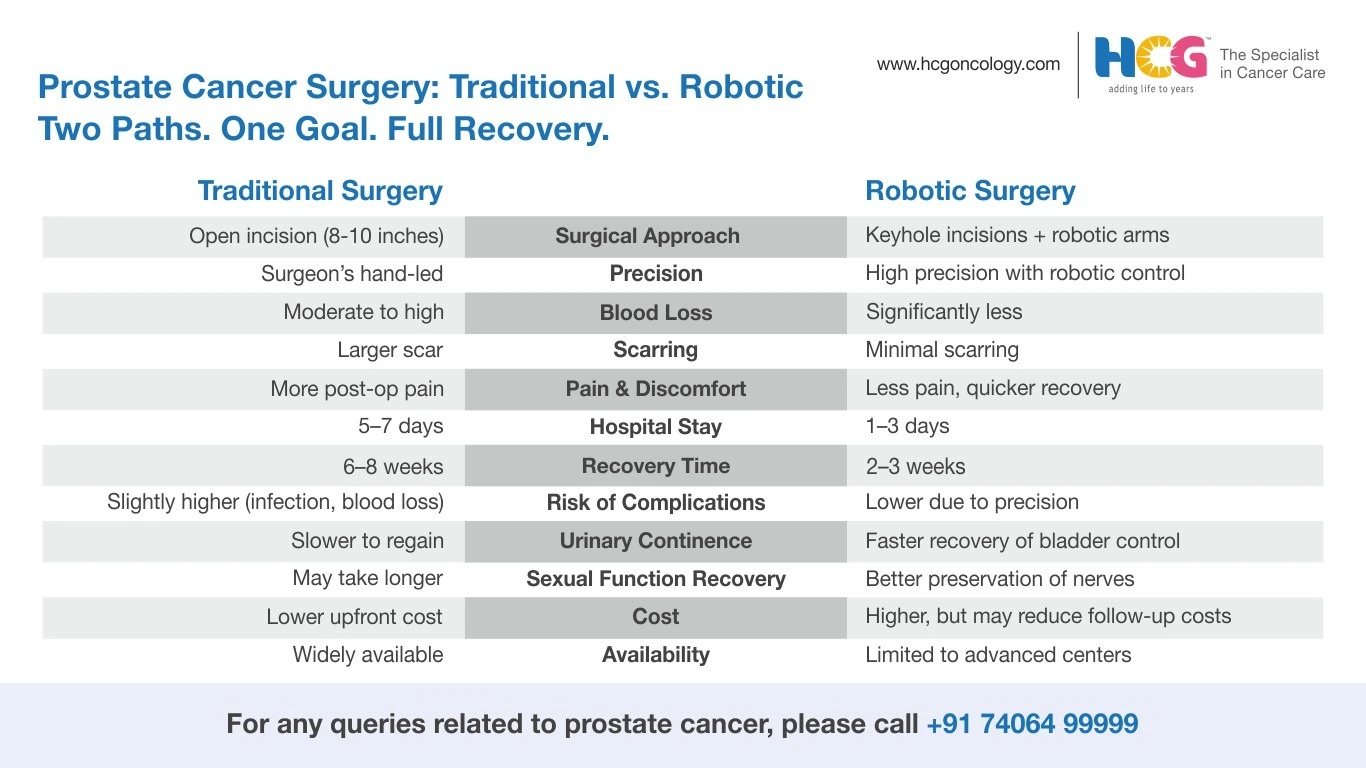
07 Nov, 2025
Feel free to reach out to us.

07 Nov, 2025

This article is medically reviewed by Dr. Saket Sathe, Consultant - Uro Oncology and Robotic Surgery, HCG Cancer Centre, Borivali.
Did you know that the 5-year survival rate for early-stage prostate cancers treated with surgery is nearly 100%?
Yes, surgery is one of the most effective treatment options for prostate cancer that is localized to the organ.
Over the years, this treatment approach has evolved significantly, and today, we have robotic surgery and minimally invasive approaches that not only improve outcomes for patients but also improve their quality of life.
In this blog article, let’s explore how traditional prostate cancer surgery is different from robotic prostate cancer surgery and how they impact patients.
Traditional surgery for prostate cancer, or open prostatectomy, involves prostate gland removal by making a large incision in the perineum or lower abdomen.
Open prostatectomy is now less frequently used because of the availability of minimally invasive techniques. However, open surgery is still effective in selected patients.
The two main types of open surgeries are radical retropubic prostatectomy and radical perineal prostatectomy.
During the radical retropubic prostatectomy procedure, an 8-10-inch incision is made in the abdomen for accessing and removing the prostate gland. Although this technique allows for the removal of nearby lymph nodes, it causes heavy blood loss, a longer recovery period, and an increased risk of complications.
During the radical perineal prostatectomy, the surgeon makes an incision between the anus and the scrotum. Although this technique takes relatively less time and causes less pain, it carries a higher risk of erectile dysfunction. Also, it does not allow lymph node removal.
Both these surgery types involve the placement of a catheter after the surgery for 7 to 14 days. Although open prostatectomy is effective, it has a higher risk of infection, more extended hospital stays, and a longer recovery period compared to minimally invasive techniques.
Doctors at HCG Cancer Centre are often asked what robotic surgery is, especially for prostate cancer.
Robotic radical prostatectomy is also called robot-assisted prostate cancer surgery. It is an advanced minimally invasive surgery used for treating prostate cancer.
It is one of the most common methods for removing the prostate gland. The surgeon, during robotic prostatectomy, makes several tiny incisions (cuts) in the lower abdomen rather than one large incision.
Through these small incisions, the robotic arms enter the target site to remove the prostate gland. The surgeon controls these arms. Robotic arms, when controlled by experienced surgeons, improve surgical precision and accuracy.
During robotic surgery for prostate cancer, the surgeon sits at the control console and controls the robotic arms using their hands and feet.
The robotic arms enable accurate movements in areas that are difficult to reach with conventional prostatectomy. It improves the surgical outcomes in various surgical events, such as during prostate removal and preservation of the surrounding nerves and tissues.
The advantages of robotic prostatectomy compared with traditional open surgery are less blood loss, fewer complications, smaller scars, and a shorter hospital stay.
Several patients experience faster recovery and a quicker return to daily activities. The outcomes of robotic surgery for prostate cancer related to cancer control, sexual function, and urinary continence are more favorable compared to traditional open surgery.
Because of these advantages of the robotic prostatectomy, it has become a preferred surgical option for many patients diagnosed with prostate cancer, especially in the early stages, and other diseases that require removal of the prostate gland.

The robotic prostatectomy vs. open prostatectomy has the following characteristics:
Surgical accuracy and precision: Robotic surgery for prostate cancer has superior accuracy and precision compared to conventional prostatectomy.
The 3D imaging and robotic arms ensure higher visualization and smooth movements. This ensures less damage to surrounding healthy tissues and nerves.
On the other hand, open surgery offers manual control with limited visibility and reduced precision, particularly when working in hard-to-reach areas.
Level of invasiveness: As compared to robotic prostatectomy, open surgery is more invasive and requires an 8–10-inch incision.
It increases the risk of blood loss, longer recovery, and pain. Robotic prostate cancer surgery is minimally invasive and is performed through small incisions.
The low level of invasiveness associated with the robotic approach results in reduced tissue damage, a faster recovery, and reduced post-surgical discomfort.
The key benefits of robotic radical prostatectomy include:
A less invasive characteristic of robotic prostate cancer surgery is an important advantage over conventional surgery.
With small incisions, patients with robotic surgery experience less blood loss, minimal tissue damage, and reduced pain after the surgery.
Robotic prostatectomy allows for faster recovery, shorter hospital stays, better preservation of sexual and urinary function, and fewer complications than conventional surgery.
Enhanced surgical visibility is another advantage of robotic surgery for prostate cancer over open prostate cancer surgery.
Robotic surgery utilizes a 3D high-definition camera for enhanced visibility of the prostate and surrounding tissues and nerves, resulting in improved surgical accuracy. It assists in preserving the surrounding tissues and nerves.
Patients undergoing robotic prostatectomy have fewer complications compared to those undergoing open prostatectomy.
Improved visibility and precise movements of the surgical arms result in better preservation of the surrounding nerves and tissues. Also, minimally invasive procedures enable faster recovery.
Robotic surgery utilizes advanced technology that offers greater surgical accuracy and precision compared to conventional prostatectomy.
The highly sensitive robotic arms enable fine, precise, and accurate actions with minimal tremor. 3D high-definition cameras enhance visualization.
The combination of advanced systems offers precise dissection of the tissues and facilitates seamless prostate removal. It also preserves the surrounding vital tissues and nerves.
Robotic prostatectomy offers better surgeon control and ergonomics than conventional open surgery. Surgeons operate from the console with delicate controls, thereby minimizing the physical strain and fatigue.
Advanced robotic systems enhance hand stability and precision, enabling better control over movements. It results in improved surgical performance and better surgical outcomes.
The benefits of robotic surgery often outweigh its limitations, and therefore, this is becoming a preferred treatment option for early-stage prostate cancer cases.
Additional Reading: Benefits of Robotic Surgery for Localized Prostate Cancer
Traditional prostate surgery involves manual incision and manual removal of the prostate gland. Robotic prostate surgery involves advanced robotic arms and a 3D high-definition camera that offers better surgical outcomes.
The advantages of robotic prostatectomy over traditional prostatectomy are fewer complications, less blood loss, faster recovery, shorter hospital stays, better preservation of sexual and urinary function, and a quicker return to work.
For more information on prostate cancer surgery in Mumbai, please reach out to HCG Cancer Centre, a top-ranking cancer hospital in Mumbai with comprehensive cancer diagnostic and treatment services.

Dr. Saket Sathe
Consultant - Uro Oncology and Robotic Surgery
Dr. Saket Sathe is an experienced urologist and uro-oncosurgeon with over 8 years of expertise, focusing on genitourinary surgeries and laparoscopic techniques for managing prostate, kidney, and bladder cancers. He is available for consultations at HCG Cancer Centre, a leading cancer hospital in Borivali. He has performed more than 5,000 urological procedures, including over 500 uro-oncosurgeries, and is recognized for his compassionate patient care. Dr. Saket has also received training in robotic surgery using the da Vinci X Robotic Surgery System.